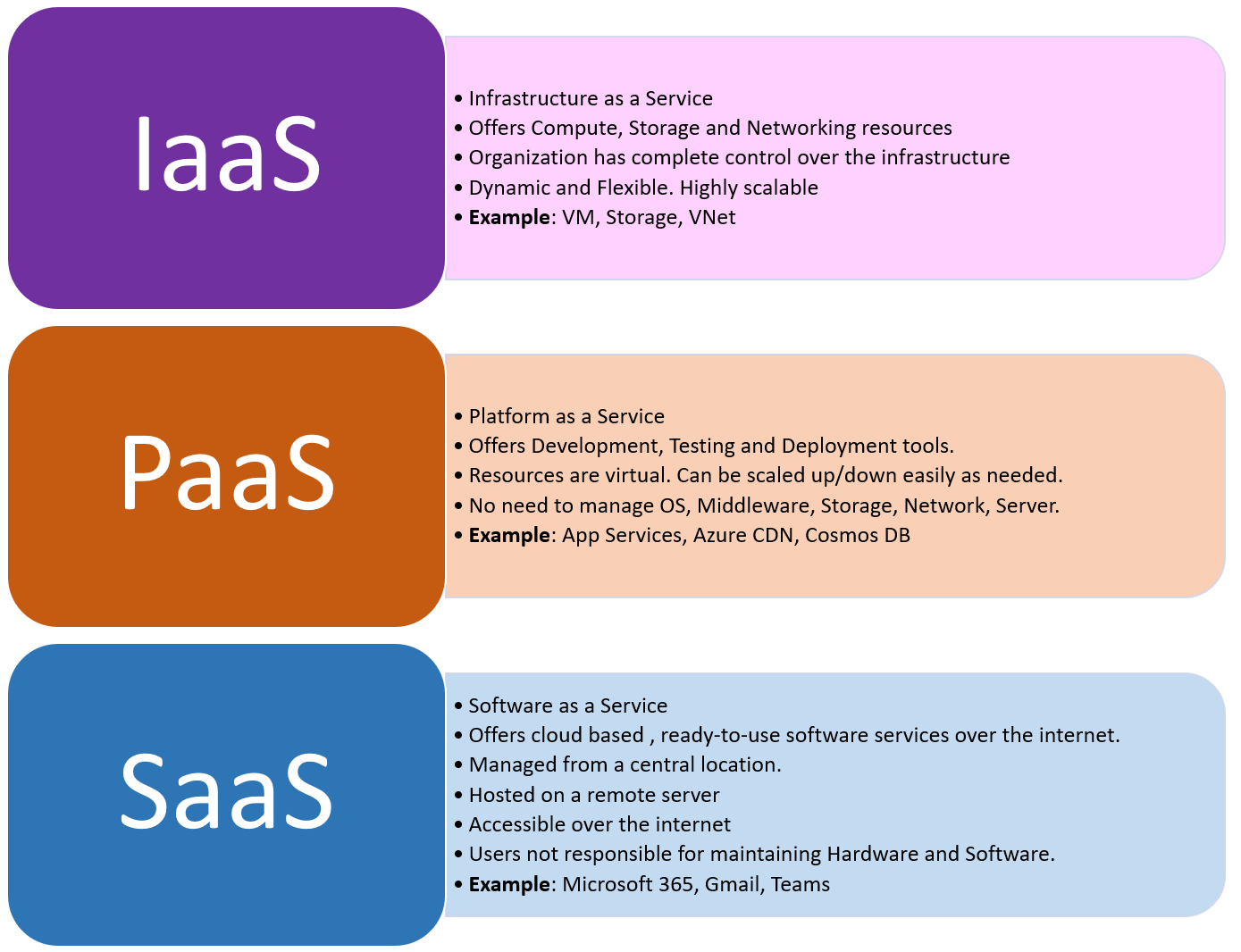Cloud Service Models
There are four types of cloud service models.
- IaaS – Infrastructure as a Service
- PaaS – Platform as a Service
- SaaS – Software as a Service
- Serverless
Refer to the figure for a brief.

IaaS: Infrastructure as a Service
- IaaS is a type of cloud service that offers compute, storage, and networking resources.
- Basically, if you want to move your company infrastructure/hardware usage to the cloud, you are opting for IaaS.
- No ownership of Hardware from the user.
IaaS Business Scenarios
- Lift and Shift Migration: This is the fastest method of migrating infrastructure load from on-premises to the cloud platform. You can scale up/down your existing infrastructure, you can add some additional security.
- Dev and Test environments: According to your requirements, you can quickly set up environments for development and testing and after you are done with them you can just decommission them.
- Backup, Storage, and Recovery: Usually, a skilled IT department and a lot of effort are needed for planning and implementing regular backups, Storage of data, and recovery of data in cases of loss. IaaS makes it easier for the organization to handle such scenarios.
Advantages of IaaS
- Cost: The direct saving is that no physical data center or large servers are needed by organizations to maintain and develop applications and data. The pay-as-you-go model can effectively set up the entire infrastructure in the cloud in a cost-effective way.
- Disaster recovery and Business continuation: Managing and Recovering the disaster situation is very difficult and an organization needs a very skilled task force and a lot of money for that. With proper SLA (Service Level Agreement) in place, IaaS helps to reduce this cost and effort.
- Stability and Reliability and support: No need to upgrade and maintain hardware. With a proper SLA in place, the service provider will do that for you.
- Security: Again, with help of proper SLA, the service provider will take care of your infrastructure and data security.
- Faster New or Upgraded Infrastructure: In IaaS, any new app or service is quickly available to enhance your ongoing development rather than waiting for a long time. This way IaaS helps you deliver the applications to your users faster.
PaaS: Platform as a Service
- PaaS is a complete development, testing, and deployment infrastructure that gives all the tools and resources which are required to deliver a complete solution.
- PaaS provides organizations with ready-to-use hardware and software which users need to access over the internet using the browser.
- PaaS providers keep hardware and software in their own infrastructure, so the developers don’t need to install any of them for the development.
- PaaS is a superset of IaaS. All the resources which are there in IaaS are also available in PaaS, like servers, storage, and networking resources. Additionally, PaaS provides development tools, testing tools, deployment tools, middleware, Business Intelligence (BI) services, and more.
PaaS Scenarios/Examples
- Application design and development tools
- Web Service Integrations:
- Application testing and deployment:
- Database Backend integration:
- Information Security:
PaaS Advantages:
- Development Framework: Provides the development framework to the organization for all the steps in Software Development Life Cycle (SDLC).
- Cost: Developers don’t need to invest in hardware and software installations and licenses. The Pay-as-you-go model helps organizations to work on the tools that they cannot afford to purchase.
- Scalability: You can quickly scale up and down the resources especially the hardware, like VM, Storage, CPU, memory, etc.
- Support for Scattered team: even if the developers are not co-located, they can access the resources over the internet and continue their work without any disconnectivity.
- Multiple platform development support: Some PaaS service providers, gives development options for multiple platforms like desktop, mobile, tablet, which helps immensely in cross-platform application development.
SaaS: Software as a Service
- SaaS allows users to use cloud-based software services over the internet.
- SaaS provides ready-to-use software applications, like Office applications, messenger services, email services, media storage services like google drive, dropbox, one drive, etc.
- All hardware and software needed for SaaS services are kept in the service provider’s data centers. Users only pay for the application and that too on a pay-as-you-go basis.
SaaS Scenarios/Examples
- Microsoft O365
- Web-based Email Services like Gmail, Yahoo mails, etc.
- Messenger services like WhatsApp, Facebook Messenger
- Media (photos, videos) Storage services
- Other services like Calendar, calculator, meeting services
- Applications like document management systems, CRM (Customer Relationship Management), ERP (Enterprise Resource Planning), etc.
Advantages of SaaS
- Access sophisticated applications: You get access to well-made and well-tested applications without worrying about any kind of infrastructure (Hardware, Software, Licenses) setup.
- Scalability: SaaS services automatically scale up and down based on the usage of the applications.
- Low or No maintenance: SaaS services are robust applications handled by service providers and that’s why usually there’s no maintenance required by the organization.
- No issue with software up-gradation: SaaS application updates are also managed by service providers so there’s no headache of constantly checking and doing the upgrades of the existing applications. The same software version is used by all the users.
Serverless:
- The developers can work on the Serverless model without worrying about setting up the infrastructure.
- The serverless model increases the productivity of the organization so the developers can deliver the application quickly.
- It is not like there is no server or data storage involved. Obviously, the infrastructure is involved but the infrastructure setup activities are invisible to the user.
- The serverless model encourages developers to put their focus only on application development and innovation rather than putting extra time and money in VM setup, tools setup, OS installations, and all that.
- Example: Azure functions
Shared Responsibility Model
